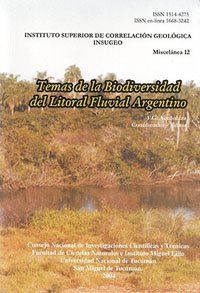Miscelánea 12
Las especies exóticas invasoras en los sistemas de humedales. El caso del Delta inferior del Río Paraná
Fabio A. Kalesnik | Ana Inés Malvárez
Descargar trabajo en formato PDFAbstract
EXOTIC INVADER SPECIES IN WETLAND ECOSYSTEMS. THE CASE OF THE LOW DELTA OF THE PARANA RIVER.-. Wetlands are ecosystems whose functioning relies on hydrologic regimes and small variations of flooding pulses or flooding levels that may produce massive changes in the local biota. These systems are particularly vulnerable to invasion processes, where variations of hydrologic regimens may cause changes in community composition and structure, and are considered to be one of the causes of incorporation of alien species.
The delta of the Paraná river may be considered as a mosaic of wetlands, where 11 landscape units may be characterized by different flooding regimes and landscape patterns. In particular, the “Lower Delta Islands” Unit, is characterized by a highly fragmented landscape constituted by natural (marsh and relict patches of native forests) and anthropic environments (Salix commercial afforestations). These juxtapositions may increase considerably the probability of dispersion of alien species.
Burkart (1957) mentions 29 exotic species for natural environments. In more recent works only 11 exotic species are mentioned. Lowland environments (marsh) present 4 exotic species (iris, Iris pseudacorus; honeysuckle, Lonicera japónica; Chinese privet, Ligustrum sinense and blackberry, Rubus spp.) but these species do not behave as invaders, since they present very low constancy and cover values. On the other hand, relict patches of native forests, present high cover values for privet, (Ligustrum lucidum), honeysuckle, White mulberry (Morus alba), and maple (Acer negundo).
What respects anthropic environments, Valli (1990) analyzed succesional trends in lowland forestations, mentioning 5 exotic species (iris, Faux indigo (Amorpha fructicosa), honeysuckle, and privet), all of them with low cover values. Kalesnik (2001) studied commercial forestations on levee that presented 16 exotic species, of which only 7 behaved as invaders: privet, Fraxinus pennsylvanica, black acacia (Gleditsia triacanthos), honeysuckle, blackberry, maple and Ligustrum lucidum. The development of each species varied among different subunits (“A”, “B” or “C”) of the Lower Delta. While unit “A” presented a very low invasion index, low cover development of alien, and none of the species behaving as invaders, the other two units (“B” and “C”) presented mean values of the invasion index and a high cover of the mentioned exotic species. In unit “A”, the fluvial influence of the Paraná river, acting together with extraordinary flooding events and the fire caused intentionally for hunting activities, may be a possible explication for the absence of invader species.
Finally, it may be stated that of a total of 102 exotic species introduces in the Lower Delta, 8,82% behave as invaders in the island sector. This value is in concordance with the pattern found for temperate ecosystems, where only a 10% of introduced species behave as invaders, in contrast to tropical ecosystems, where that proportion is close to 100%.






